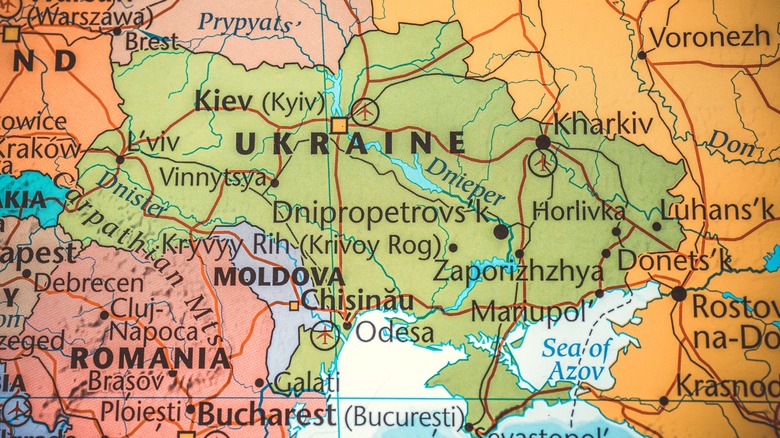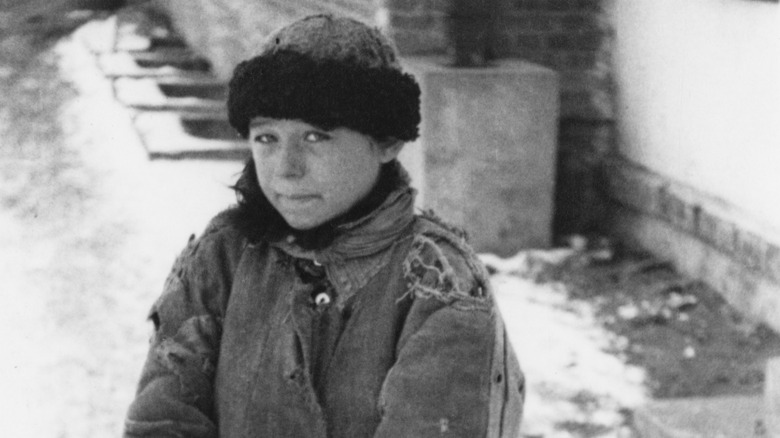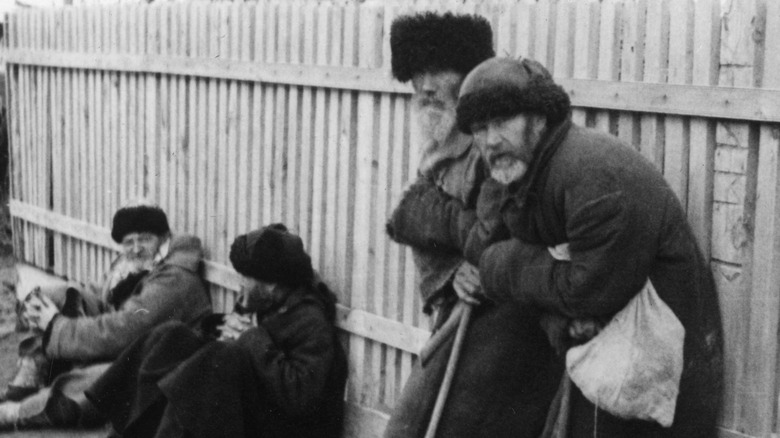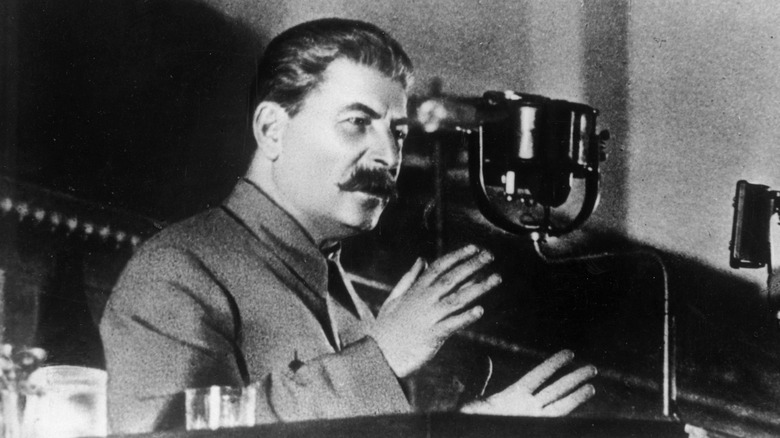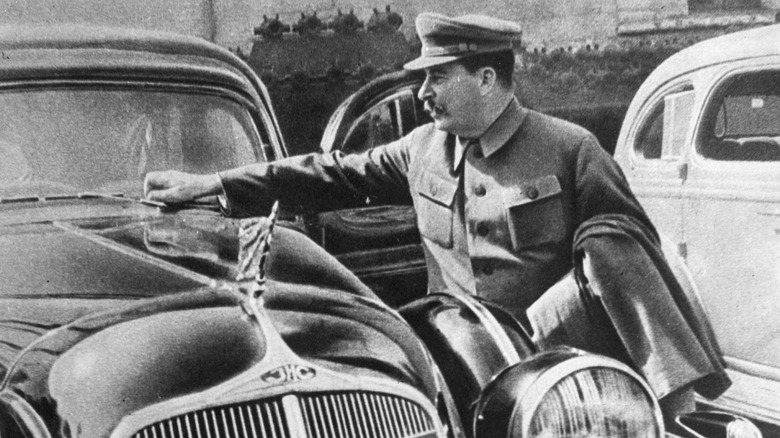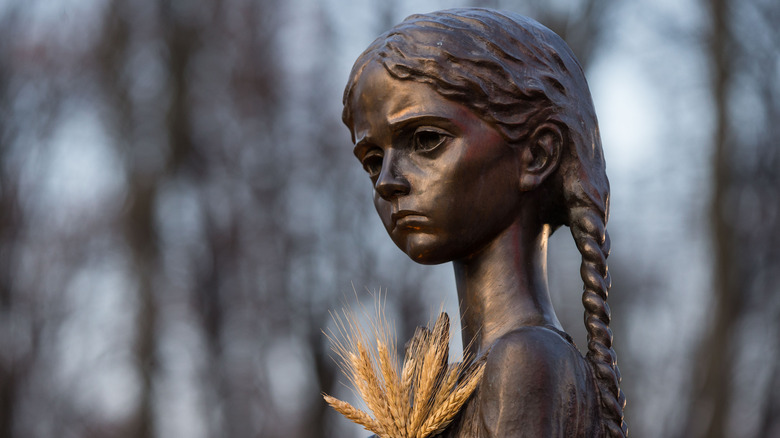The Truth About The Stalin-Era Famine That Killed Millions Of Ukrainians
From 1931 to 1934, the Soviet Union was gripped by famine, as Britannica reports. From 1932 to 1933, that crisis was perhaps felt most acutely in the then-Soviet republic of Ukraine, once called the breadbasket of Europe (per Marketplace). This period of Ukrainian history is now known as Holodomor, from the Ukrainian words for hunger and death. According to some estimates, nearly 4 million Ukrainians died during the famine, believed to be 13% of the entire Ukrainian population at the time (via History).
What caused the terrible suffering endured by the Ukrainian people during this period was not drought or some other act of nature. Instead, it's believed by some to have been a systematic undertaking on the part of then-Soviet leader Joseph Stalin's communist regime. His aim was to collectivize agriculture in Ukraine, while also breaking the back of Ukrainian resistance to Soviet rule. What was also undertaken by Stalin was a genocide of the Ukrainian people, in the opinion of many historians as well as the Ukrainian government (per University of Minnesota).
The famine begins
In 1929, the collectivization of Ukrainian agriculture was well underway, ordered by Soviet leader Joseph Stalin. According to Britannica, parts of this process involved taking by force privately-held agricultural land from traditional Ukrainian farming families. Those affected by the Soviet policy were not just required to give up their land, either. They were no longer allowed to have private property of any kind, and some peasant farmers were relocated to state-owned agricultural operations against their will.
This process was disorganized. And as is often the case when human beings are forced to do things not of their choice, resistance to these Soviet policies was rampant all throughout Ukraine. As a result, crop productivity dropped, leading to food shortages (via Britannica). This was not strictly an unforeseen outcome from the Stalinist government. Ukraine had offered especially fierce resistance to the Red Army during the Russian Civil War some years prior. For this reason, Stalin targeted Ukraine with policies meant to starve the population into submission, in the view of some experts (via University of Minnesota).
Kulaks are targeted
The Ukrainian population pushed back fiercely against Stalin, particularly as productivity fell, food became scarce, and help was not offered from Moscow. Wealthy Ukrainian farmers who put up a fight were labeled "kulaks," according to History. Communist forces drove these kulaks off their own property, relocating tens of thousands of them into Siberia. When it became clear that collective Ukrainian farming would not produce adequate amounts of food, based on benchmarks set by the Soviets, what food remained was confiscated by Moscow, offering additional evidence that the Ukrainian suffering was intentional.
According to History, a number of Ukrainians were also called saboteurs during this period. Intellectuals and teachers were imprisoned or thrown in work camps, or gulags, while people's homes were searched for any additional food they might be hiding from Soviet authorities. Stalin also banned the Ukrainian language, as well as other vestiges of independent Ukrainian culture. All the while, food became ever more scarce, the population suffered, and thousands died, while the Stalinist government turned a blind eye.
The death rate spikes
By 1933, the death toll related to Stalin's agricultural policies and persecution of the Ukrainian people reached an apex (via Britannica). The dead were thrown in mass graves, and there is evidence that desperate Ukrainians turned to cannibalism and even ate their own pets and farm animals (per History). Lawlessness spread all throughout Ukraine, which included robberies and lynchings, among other crimes. Although urban Ukrainians were allowed ration cards, they hardly fared better than those trapped in the countryside.
Still, no help came from Moscow, and the Soviet secret police cracked down even harder on the Ukrainian people. Around this same time, so many Ukrainians were imprisoned, died, or had been thrown into gulags, there were not enough people left to work the Soviet collectivist farms. For this reason, Stalin began forcibly relocating Russian peasants from other areas of the country to Ukraine. Stalin's own wife objected to these policies, among others, and it's not believed she killed herself as a result (per The New York Times). So, too, did the leader of the Ukrainian communist party (per Britannica).
The cover-up starts
News of the immense suffering of the Ukrainian people was largely suppressed by the Soviet Government. Even New York Times Moscow correspondent Walter Duranty was largely a Stalin apologist, per The Atlantic, although another young American journalist named Gareth Jones, who died under mysterious circumstances, did his best to get the word out (via Britannica). Soviet communist party officials never mentioned the suffering of the Ukrainian people, and census numbers reflecting the full extent of the famine on the Ukrainian population were kept hidden, while the census-takers were either jailed or killed.
Perversely, Holodomor was more widely recognized in Ukraine under Nazi occupation in 1941 during World War II. Following that, the first official Soviet mention of what had happened came some half-century later in the wake of the Chernobyl nuclear disaster, which also happened in Ukraine. That's why the United States recognition of the Ukraine famine and genocide would not happen until 2019 (per Britannica). When the Soviet Union fell, the Russian government admitted the Ukrainian famine, but denied it was genocide (per History).
A possible genocide is recognized
Holodomor has now been officially recognized by the United States Congress as a genocide, calling it a "a man-made famine that took the lives of millions of Ukrainians, including persons of other nationalities living in Ukraine at that time," according to the Holodomor Museum website. Along with that, recognition of the atrocities endured by the Ukrainian people under the hands of the Stalin-era Soviet government has spread to 16 other countries, even reaching the Vatican, per Britannica. As recently as 2008, though, the Russian government denied the Ukrainian famine was genocide, stating: "There is no historical proof that the famine was organized along ethnic lines" (via Boston).
All throughout Ukraine, monuments and other memorials have sprung up to commemorate the calamity. Holodomor Remembrance Day is observed on the fourth Saturday of November each year. None of this can alleviate the suffering of the Ukrainian people at the time or the painful place that Holodomor has in world history. But in learning the truth about dark periods in time such as these, efforts can be made to prevent them from ever happening again.
